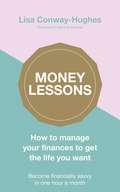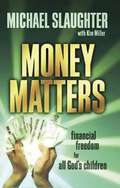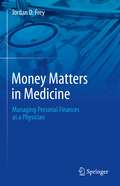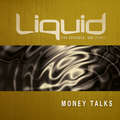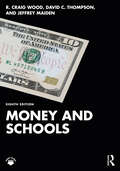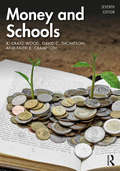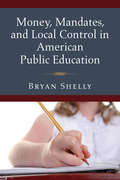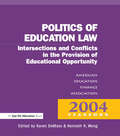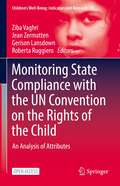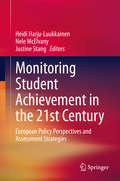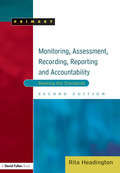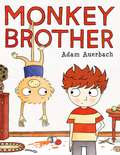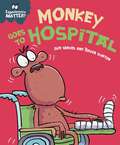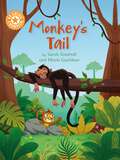- Table View
- List View
Money Lessons: How to manage your finances to get the life you want
by Lisa Conway-HughesIf you spent one hour a month nurturing your finances for the next twelve months, how would you feel this time next year, what would be different? Mapping out a plan for achieving your big goals and managing everyday spending, Money Lessons is your own pocket financial expert. Whether you have it or not, money is often as difficult to talk about as it is to handle. Many of us will at one point need advice on how to:- ask for a pay rise- save up to buy a place- pay for a mortgage- finance a career move- budget for a wedding- fund a big trip- get out of debt- retire comfortablyBuilding on her 15 years of experience helping countless people to make smart financial decisions, Lisa Conway-Hughes tackles these topics in a short guide to being savvy and getting what you want in every stage of your life. Full of expert knowledge and success stories, this is essential reading for anyone who wants to turn a dream into a plan - and eventually a reality.
Money Matters Participant's Guide: Financial Freedom for All God's Children
by Mike Slaughter Kim MillerA complete stewardship kit to prepare your congregation for generosity.Outline (7 sessions): 1. The Celebration of Creation2. The Freedom of Simplicity3. The Life of Generosity4. The Trust of Rightful Ownership5. The Joy of Faithful Stewardship6. The Faith in Promised Provision7. The Commitment to Ultimate SacrificeTarget audience: Participants guide: small groups in congregation; with at least the trustees and the church board.
Money Matters in Medicine: Managing Personal Finances as a Physician
by Jordan D. FreyThis book addresses both the philosophical and more tangible actionable components of attaining financial well-being as a medical professional. In an engaging, narrative-driven format, it relays the importance of managing one’s finances—even with the high salary of a doctor. Money Matters in Medicine is an accessible, invaluable resource for early-career physicians who wish to incorporate intelligent money management skills in their development as medical professionals. Chapters include information on becoming financially literate, how to approach insurance, creating a savings rate, and the top mistakes most doctors make with their money. Though there are many financial self-help books in the market, this book stands out, as it rests on philosophies and core standards held by those in the medical community. It presents the strategies to promote financial well-being and ultimately help doctors become more effective physicians with financial freedom. The book includes easy-to-understand guidelines and intuitive steps for readers to take massive action in their lives to improve their financial well-being.
Money Talks Participant's Guide: Five Episodes, One Story) (Liquid)
by John Ward Jeff PriesLIQUID will revolutionize the way you view small group study. This 112-page Participant's Guide with questions and leader's tips acts as a companion to the DVD, available in the Leader's Kit. Each episode introduces present-day characters whose problems and struggles mirror biblical stories, illustrating that God's Word is as true today as it was when it was written. With emotionally provoking videos, introspective questions, and tips for leading a small group, LIQUID is the perfect experience for individual growth or small group study.
Money and Interculturality: A Theory (New Perspectives on Teaching Interculturality)
by Fred DervinThis book challenges the silence surrounding money, revealing its profound influences on personal and social identities and power dynamics in intercultural contexts.In this inimitable book, Fred Dervin continues to explore the notion of interculturality by offering a novel and critical exploration of the often-overlooked role of money, especially within the broad field of Intercultural Communication Education and Research (ICER). Adopting a robust interdisciplinary lens and drawing on concrete examples, the author combines, for example, financial education, literature, philosophy and sociology to critique the economic and moral dimensions of global interactions in today's confused and confusing world. From examining the commodification of intercultural relations to proposing shared responsibility and ethical reasoning, Money and Interculturality: A Theory provides a fresh perspective on how money shapes and often distorts interculturality. Based on a unique integration of contemporary, historical and literary insights, Dervin questions and deepens our understanding of interculturality while equipping readers with new vocabulary and frameworks to address the harsh realities of global, unpredictable and power-laden communication.This somewhat provocative book represents an essential reference for educators, practitioners, researchers and students seeking to investigate the connections between money and interculturality.
Money and Possessions: The Quest for Contentment (40-Minute Bible Studies)
by Kay Arthur David ArthurIn these days of economic uncertainty, and in a society that values financial security, money is an emotional topic. Appearances and lifestyle matter to us. And money-or the lack of it-often determines whether or not were content. The truth is, our attitudes toward money and possessions reflect the quality of our relationship with God. And, according to the Scriptures, our view of money reveals where our true affections lie. Prosperity is not a sin, but it does bring responsibilities. And scarcity is not a virtue, particularly when it distracts us from the things that truly matter. In this six-week study you will discover God's view of material wealth. As you dig into the Scriptures, you'll learn where money comes from, you'll see how we're supposed to handle it, and you'll understand how to live an abundant life, regardless of your financial circumstances.From the Trade Paperback edition.
Money and Schools
by David C. Thompson R. Craig Wood Jeffrey A. MaidenMoney and Schools explains and demonstrates the relationship between money and equality of educational opportunity in a way that is clear, precise, and engaging. Grounded in research and best practices, this book provides a broad overview of school finance, budgeting, and resource allocation, an understanding of the underlying economic, social, legal, and political principles that drive how schools are funded, as well as a detailed examination of day-to-day funding operations. Rich pedagogical features include chapter drivers, point/counterpoint discussions, case studies, portfolio exercises, and web and recommended resources. This accessible and engaging book offers strong connections to real-world experiences and detailed information on preK–12 funding history, concepts, and current operations for both aspiring and experienced education leaders in school budgeting, finance, and resource management courses. New to this edition: Coverage of new concepts and trends, such as the political economy and culture of public education. Inclusion of cutting-edge research on the impacts of money on student learning outcomes. Expanded chapter-by-chapter annotations and recommended resources that point readers to other resources and explain key concepts in greater detail. New online supplemental downloads, including updated PowerPoints for Instructors and chapter-based interactive figures for download.
Money and Schools (4th Edition)
by David C. Thompson Faith E. Crampton R. Craig WoodFor future principals and others enrolled in courses on School Finance, this book explains and demonstrates the relationship between money and student achievement. New to this edition - Includes updated information on the ever-changing landscape of school finance. - Co-author Faith E. Crampton has joined the author team, applying the expertise she has acquired in public education, state government, national education and legislative organizations, and universities. - Chapters now include a section titled "Point - Counterpoint", offering opposing views on issues involving money and schools along with incisive questions to help guide classroom debates and/or individual analysis. - Case studies throughout the text provide opportunities to apply the knowledge gained in each chapter. - Also includes web sites and extensive recommended bibliography.
Money and Schools: A Handbook For Practitioners (The\leadership And Management Ser.)
by Faith Crampton R Wood Craig David C ThompsonIn the new edition of this essential, all-inclusive text, the authors provide more important research for future principals and others enrolled in graduate-level school finance courses. Written in a style that is highly readable, the book offers strong connections to real-world experiences. Readers get both a broad overview of funding concepts and a detailed examination of daily funding operations and will come away with a deep understanding of the relationship between money and student achievement. New to this edition:Current research on the impact of money on student learning outcomes, New concepts that are gaining traction, such as sustainability, Current web resources and recommended reading
Money and Schools: A Handbook For Practitioners (The\leadership And Management Ser.)
by David C. Thompson Faith E. Crampton R. Craig WoodFor both aspiring and experienced education leaders in school budgeting, finance, and resource management courses, Money and Schools explains and demonstrates the relationship between money and equality of educational opportunity. Grounded in research and best practices, this book provides a broad overview of school finance, budgeting, and resource allocation, as well as a detailed examination of day-to-day funding operations. This accessible and engaging book offers strong connections to real-world experiences and detailed information on pre-K-12 funding history, concepts, and current operations. New to this edition:* Cutting edge research on the relationship of money and student learning outcomes, alterations to state aid distribution formulas, new federal education initiatives, and a changing landscape in school finance litigation.* New concepts that have gained traction since the last edition of the book, including school choice and privatization, Common Core State Standards, value-added teacher evaluation, and growth of online options at the K-12 level.* Updated end-of-chapter activities and additional resources that are aligned with the key concepts and content of each chapter.
Money and Schools: A Handbook For Practitioners (The\leadership And Management Ser.)
by David C. Thompson Faith E. Crampton R. Craig WoodFor both aspiring and experienced education leaders in school budgeting, finance, and resource management courses, Money and Schools explains and demonstrates the relationship between money and equality of educational opportunity in a way that is clear, precise, and engaging. Grounded in research and best practices, this book provides a broad overview of school finance, budgeting, and resource allocation, an understanding of the underlying economic, social, legal, and political principles that drive how schools are funded, as well as a detailed examination of day-to-day funding operations. Rich pedagogical features include chapter opening challenges, chapter drivers, point/counterpoint discussions, case studies, and recommended resources. This accessible and engaging book offers strong connections to real-world experiences and detailed information on pre-K–12 funding history, concepts, and current operations. New to this edition: Coverage of environmental sustainability and other emerging trends in this unprecedented uncertainty of schools' economic and social environment. Updates to references and overall funding changes since the previous edition. Revised end-of-chapter activities and additional resources that are aligned with the key concepts and content of each chapter. Updated supplemental downloads, including editable PowerPoints.
Money for Good Grades and Other Myths About Motivating Kids: Strategies for Parents and Teachers
by Barbara R. BlackburnIn this helpful resource, expert educator Barbara R. Blackburn guides parents through the top eight myths about motivation and reveals what really works for kids. Each chapter is filled with practical information and stories that help you understand how to handle a variety of situations related to your child’s success at school. Blackburn helps you get to the bottom of issues such as: • Is motivating with rewards effective? • What if your student doesn’t care about school? • How does your relationship with your student affect their motivation? • How can you set high expectations without too much pressure? • Is it okay for my kid to struggle, get stuck, and fail? • How does competition affect success in school? • What should you do when nothing seems to be working? Chapters also include specific classroom connections for each strategy, so you can begin proactively working with your child's teacher. With the accessible advice in this book, you’ll be able to reach your child more effectively so that he or she is more motivated from within, and more successful in school and beyond! Bonus: Guides for collaboration between parents and schools are available on our website at www.routledge.com/9781138368200 so that schools can use the book to work more effectively with parents through PTA and PTO organizations, family support groups, and more. You'll also find a guide for parents to use to facilitate book clubs or reading groups.
Money, Mandates, and Local Control in American Public Education
by Bryan ShellyPointing to the disparities between wealthy and impoverished school districts in areas where revenue depends primarily upon local taxes, reformers repeatedly call for the centralization of school funding. Their proposals meet resistance from citizens, elected officials, and school administrators who fear the loss of local autonomy. Bryan Shelly finds, however, that local autonomy has already been compromised by federal and state governments, which exercise a tremendous amount of control over public education despite their small contribution to a school system's funding. This disproportionate relationship between funding and control allows state and federal officials to pass education policy yet excuses them from supplying adequate funding for new programs. The resulting unfunded and underfunded mandates and regulations, Shelly insists, are the true cause of the loss of community control over public education. Shelly outlines the effects of the most infamous of underfunded federal mandates, the No Child Left Behind Act of 2001 (NCLB), and explores why schools implemented it despite its unpopularity and out-of-pocket costs. Shelly's findings hold significant implications for school finance reform, NCLB, and the future of intergovernmental relations.
Money, Politics, and Law
by Kenneth K. Wong Karen DeMossThis yearbook offers research and insights to stimulate thought, inform debates, and explore future research directions.
Monica Plum's Horrid Problem: A Story For Children Of Troubled Parents (Helping Children with Feelings)
by Margot Sunderland Nicky ArmstrongThis is a story for children with troubled parents. Monica has a horrid problem. It gets everywhere: into her schoolwork, her dreams, and her ability to make friends. People keep telling her to cheer up. She can't. She feels as if she is carrying around some very heavy luggage. Then one day, a helpful teacher sees how miserable Monica is, and tells her about the knights in the world, who are posing as people. In a whispering wood, Monica finds some of these knights. They teach her how to make her problem far less horrid. In particular they show her how to cope when other people's problems weigh you down and make you feel miserable. Most importantly they show her how to do life well. Monica leaves whispering wood feeling empowered and ready to face what she could not face before.
Monitoring Progress Toward Successful K-12 STEM Education
by Board on Testing and Assessment National Research Council Division of Behavioral and Social Sciences and Education Board on Science Education Committee on the Evaluation Framework for Successful K-12 STEM EducationFollowing a 2011 report by the National Research Council (NRC) on successful K-12 education in science, technology, engineering, and mathematics (STEM), Congress asked the National Science Foundation to identify methods for tracking progress toward the report's recommendations. In response, the NRC convened the Committee on an Evaluation Framework for Successful K-12 STEM Education to take on this assignment. The committee developed 14 indicators linked to the 2011 report's recommendations. By providing a focused set of key indicators related to students' access to quality learning, educator's capacity, and policy and funding initiatives in STEM, the committee addresses the need for research and data that can be used to monitor progress in K-12 STEM education and make informed decisions about improving it. The recommended indicators provide a framework for Congress and relevant deferral agencies to create and implement a national-level monitoring and reporting system that: assesses progress toward key improvements recommended by a previous National Research Council (2011) committee; measures student knowledge, interest, and participation in the STEM disciplines and STEM-related activities; tracks financial, human capital, and material investments in K-12 STEM education at the federal, state, and local levels; provides information about the capabilities of the STEM education workforce, including teachers and principals; and facilitates strategic planning for federal investments in STEM education and workforce development when used with labor force projections. All 14 indicators explained in this report are intended to form the core of this system. Monitoring Progress Toward Successful K-12 STEM Education: A Nation Advancing? summarizes the 14 indicators and tracks progress towards the initial report's recommendations.
Monitoring School Performance: A Guide For Educators
by J. Douglas WillmsFirst published in 1992. Routledge is an imprint of Taylor & Francis, an informa company.
Monitoring State Compliance with the UN Convention on the Rights of the Child: An Analysis of Attributes (Children’s Well-Being: Indicators and Research #25)
by Ziba Vaghri Jean Zermatten Gerison Lansdown Roberta RuggieroThis open access book presents a discussion on human rights-based attributes for each article pertinent to the substantive rights of children, as defined in the United Nations Convention on the Rights of the Child (UNCRC). It provides the reader with a unique and clear overview of the scope and core content of the articles, together with an analysis of the latest jurisprudence of the UN Committee on the Rights of the Child. For each article of the UNCRC, the authors explore the nature and scope of corresponding State obligations, and identify the main features that need to be taken into consideration when assessing a State’s progressive implementation of the UNCRC. This analysis considers which aspects of a given right are most important to track, in order to monitor States' implementation of any given right, and whether there is any resultant change in the lives of children. This approach transforms the narrative of legal international standards concerning a given right into a set of characteristics that ensure no aspect of said right is overlooked. The book develops a clear and comprehensive understanding of the UNCRC that can be used as an introduction to the rights and principles it contains, and to identify directions for future policy and strategy development in compliance with the UNCRC. As such, it offers an invaluable reference guide for researchers and students in the field of childhood and children’s rights studies, as well as a wide range of professionals and organisations concerned with the subject.
Monitoring Student Achievement in the 21st Century: European Policy Perspectives and Assessment Strategies
by Heidi Harju-Luukkainen Nele McElvany Justine StangThis book draws together leading student assessment academics from across Europe exploring student monitoring policies and practices in a range of countries across 22 chapters. The chapters in the first part offer a broad overview on student assessment covering history and current status, aims and approaches as well as methodological challenges of international student assessment. The second part presents country specific chapters provide an in depth look examining country specific policy and practices and findings of national and/or international assessments. Findings are critically discussed and recommendations are made for further development of each country's assessment context. The book shows similarities and differences within the educational assessment landscape as well as complexity and similarities in assessment policy documents and strategies, Given the globalized world we live in today, this book fills a need in the higher educational context and is intended for for policy makers in different countries as well.
Monitoring, Assessment, Recording, Reporting and Accountability, Second Edition: Meeting the Standards
by Rita HeadingtonThis comprehensive, practical second edition has been updated in line with the new standards for qualified teacher status, in particular the competence in monitoring and assessment. Writing primarily for student and newly qualified teachers, whose classroom experience is necessarily limited, the author takes pains to elucidate why to assess, what to assess and how to assess. Theory and practice are linked throughout by way of case studies, activities and discussion points. Question and answer format, children's work and authentic written records are used to exemplify monitoring and assessment in action as part of the planning cycle. Photocopiable examples of recording sheets and a glossary of terms provide readers with valuable starting points for their own practice.
Monkey Brother
by Adam AuerbachA clever and surprising tale of sibling rivalry and unconditional love from an Ezra Jack Keats Honor Award winner.Little brothers can be a handful. They’re wild and messy. They follow you everywhere and they love to copy everything you do. But what if your little brother was a monkey? Would he drag you into a special kind of monkey mischief? Find out in Monkey Brother, a clever and surprising tale of sibling rivalry and unconditional love from Ezra Jack Keats Honor Award winner, Adam Auerbach.A Christy Ottaviano Book
Monkey Fun! (Xist Children's Books)
by Julia DweckMonkey Fun! proves that you’re never too young to begin your learning adventure. It’s a barrel of fun and chock full of interesting monkey facts written in easy to understand rhyming verse for toddlers ages 0-4. “That’s not a monkey who’s peeling a grape. Bigger and tailless, he must be an ape.” “Monkeys who live in a family group, travel together and share with their troop.” Bold, colorful illustrations by Aida Barba Flores will capture the attention of young readers and aid in story comprehension. This is an edutaining rhyming adventure that offers fun learning resources in the back of the book including, Mrs. Dweck’s monkey facts and a monkey counting game.
Monkey Goes to Hospital (Experiences Matter)
by Sue GravesMonkey Goes to Hospital offers a gentle introduction to the experience of needing hospital treatment for young children.This funny, charming story is the perfect way to introduce young children to the experience of visiting a hospital. Also included are suggestions for activities and ideas to talk through together to help children reflect on their own experiences.Monkey is having so much fun climbing the big tree that he isn't careful and he falls. Dad says he will need to go to hospital for a check-up, but Monkey is worried. Luckily, the doctor at the hospital is very kind.The Experiences Matter series of picture books provide a gentle means of discussing experiences, boosting self-esteem and reinforcing good behaviour. Supports the Personal, Social and Emotional Development Area of Learning in the Early Years Foundation Stage, and is also suitable for use with children in KS1 and can be used to discuss values. Suitable for children under 5.
Monkey's Tail: Independent Reading Orange 6 (Reading Champion #1076)
by Sarah SnashallThis story is part of Reading Champion, a series carefully linked to book bands to encourage independent reading skills, developed with Dr Sue Bodman and Glen Franklin of UCL Institute of Education (IOE)Reading Champion offers independent reading books for children to practise and reinforce their developing reading skills.Fantastic, original stories are accompanied by engaging artwork and a reading activity. Each book has been carefully graded so that it can be matched to a child's reading ability, encouraging reading for pleasure. Perfect for 5-7 year olds or those reading book band orange.
Monkeys (National Geographic Kids Readers)
by Anne SchreiberThis comical, adorable, and fascinating reader documents the lives of monkeys living in the wild and includes details regarding their behavior, families, and environment. The carefully constructed text guarantees a successful and rewarding reading experience for level 2 readers who are able to read alone, with minor assistance. The photography and extras featured in this title ensure a fun and interactive experience for the reader.National Geographic supports K-12 educators with ELA Common Core Resources.Visit www.natgeoed.org/commoncore for more information.
